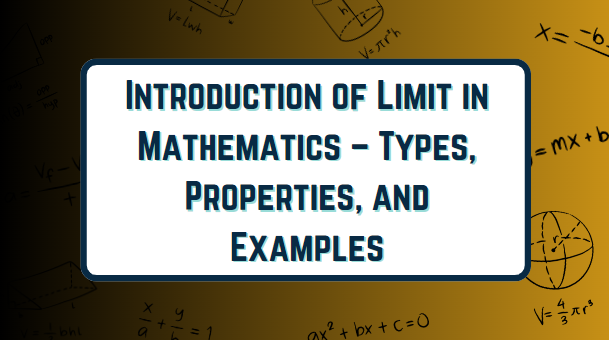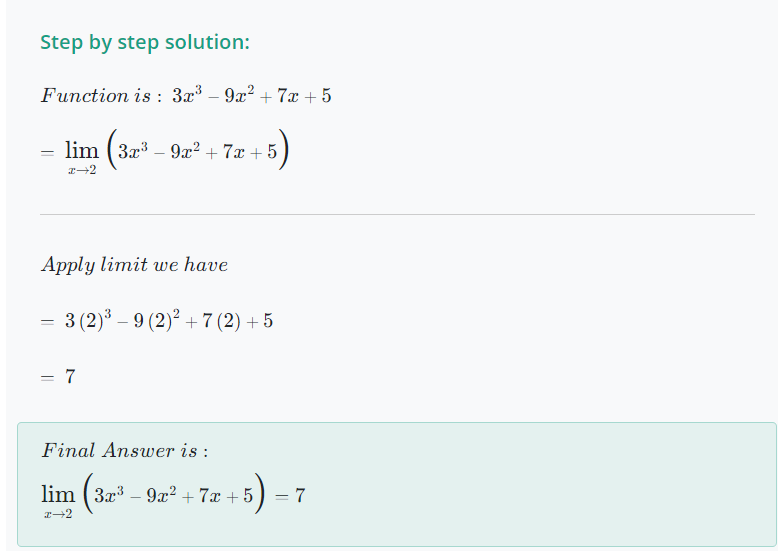
A limit is the value that a function approaches as its input (usually denoted as x) gets arbitrarily close to a specific point. Limits play a crucial role in understanding how functions behave near a specific point. The basis of derivative, series, and continuity depends on the concept of limits.
We will delve deeply into the concept of limits in this article. We will talk about the definition, types, and properties of limits. We will learn how to calculate limits with the help of some examples.
How to define a Limit?
Let f(x) be a function defined in an open interval containing the point ‘c’, except possibly at ‘c’ itself. If, for every positive number ε, there exists a positive number δ such that |f(x) – L| < ε whenever 0 < |x – c| < δ, then the limit of f(x) as x approaches c is L.
We use the following notation to represent the limit:

Where,
- f(x) is the function
- c is the input value x is approaching
- L is a limit value that f(x) is approaching
- x → c means “x approaches a”
Different Types of Limit
There are several types of limits with unique characteristics and notation. Some most useful types are here:
One-Sided Limits: One-sided limits are limits that approach a specific value from only one side (either the left or right side) of the function.
Two-Sided Limits: A two-sided limit considers the limit of a function as the independent variable approaches some value from both sides. The general notation for a two-sided limit is Lim x→ c f(x) = L.
Infinite Limits: Infinite limits occur when the output of the function becomes unbounded as the input approaches a particular value. The general notation for an Infinite limit is Lim x→ c f(x) = ± ∞.
Limit at Infinity: A limit at infinity represents the behavior of a function as the input approaches infinity (∞) or negative infinity (-∞).
Properties of Limits
Limits have various properties that help in their evaluation and manipulation. Understanding these properties is crucial for solving complex mathematical problems involving limits. Consider the limit of f(x) and g(x) exist as x approaches c. k is any constant. Then
- The limit of the sum or difference of two functions is equivalent to adding or subtracting the limits of the individual functions.
Lim x→ c [f(x) ± g(x)] = Lim x→ c f(x) ± Lim x→ c g(x)
- The limit of the product of two functions is equal to the product of their limits.
Lim x→ c [f(x). g(x)] = Lim x→ c f(x). Lim x→ c g(x)
- The limit of the quotient of two functions is equal to the quotient of their limits. The limit of the denominator should not be zero.
Lim x→ c (f(x) / g(x)) = Lim x→ c f(x) / Lim x→ c g(x)
- The limit of a constant multiplied by a function is equal to the constant multiplied by the limit of the function.
Lim x→ c (k f(x)) = k lim x→ c (f(x))
- The limit of a power of a function is equal to the power of the limit of the function.
Lim x→ c (f(x)) k = (Lim x→ c f(x)) k
Method for Calculating Limit
Here are some common techniques to calculate the limit.
- Direct Substitution: Functions that are defined at a given value are simply substituted into the function and evaluated. This method works for many simple functions.
- Factorization: If the function is in an indeterminate form (i.e. 0/0 or ∞/∞) you can try to factorize the expression and cancel common terms to simplify it. After simplification, you may attempt direct substitution.
- Algebraic Manipulation: You can often manipulate the function algebraically to simplify the expression, such as rationalizing the denominator or multiplying by a conjugate.
- L Hospital Rule: This rule is used when you have an indeterminate form after evaluating a limit. It involves taking the derivative of the numerator and denominator and then evaluating the limit again.
Solved Examples of Limit
Let’s learn how to determine the limit of the function with the help of some examples.
Example 1:
Evaluate Lim x→ 2 3x3 – 9x2 + 7x + 5
Solution:
Step 1: Use the limit properties to split the function into individual terms.
Lim x→ 2 3x3 – 9x2 + 7x + 5 = Lim x→ 2 (3x3) – Lim x→ 2 (9x2) + Lim x→ 2 (7x) + Lim x→ 2 (5)
Step 2: Substitute the value of ‘x’ into the function.
= 3(2)3 – 9(2)2 + 7(2) + 5
Step 3: Simplify the expression.
= 3(8) – 9(4) + 7(2) + 5
= 24 – 36 + 14 + 5 = 7
∴ Lim x→ 2 3x3 – 9x2 + 7x + 5 = 7
The limit calculations can also be done with the help of a limit calculator with steps to save time.

Example 2:
Compute the limit of the function f(x) = (x – 3) / (x2 – 9) as x approaches 3.
Solution:
Step 1: Given function is (x – 3) / (x2 – 9)
The denominator can be factored as (x + 3) (x – 3).
f(x) = (x – 3) / ((x + 3) (x – 3))
Step 2: Cancel out the common term (x – 3) in the numerator and denominator.
f(x) = 1 / (x + 3)
Step 3: Now, find the limit as x approaches 3 by directly substituting x = 3 into the simplified expression.
= Lim x→ 3 (1 / (x + 3))
Step 4: Substitute x = 3 into the expression:
= 1 / (3 + 3) =1/6
The limit of the function f(x) = (x – 3) / (x2 – 9) as x approaches 3 is 1/6.
Conclusion
In this article, we have discussed the definition of the limit with its notation. We have explored different types of limits. We covered common properties to simplify the complex problem of limits. We looked at methods to calculate the limit of the function. We provided solved examples for our readers to understand this topic in a better manner.